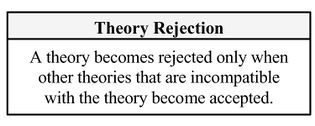Mechanism of Normative Theory Rejection
How do normative theories become rejected? What is the mechanism of normative theory rejection?
Rejection of norms is an essential part of scientific change. Thus, explaining how norms become rejected is an important for a scientonomic theory.
In the scientonomic context, this question was first formulated by Aayu Pandey in 2023. The question is currently accepted as a legitimate topic for discussion by Scientonomy community.
In Scientonomy, the accepted answer to the question is:
- A theory becomes rejected only when other theories that are incompatible with the theory become accepted.
Contents
Scientonomic History
Acceptance Record
| Community | Accepted From | Acceptance Indicators | Still Accepted | Accepted Until | Rejection Indicators |
|---|---|---|---|---|---|
| Scientonomy | 28 December 2023 | This is when Pandey's paper suggesting the first direct answer to the question was published, which is an indicator that the question itself is accepted. | Yes |
All Theories
| Theory | Formulation | Formulated In |
|---|---|---|
| Norm Rejection theorem (Pandey-2023) | A norm becomes rejected when other elements that are incompatible with the norm become part of the mosaic. | 2023 |
If an answer to this question is missing, please click here to add it.
Accepted Theories
Suggested Modifications
| Modification | Community | Date Suggested | Summary | Verdict | Verdict Rationale | Date Assessed |
|---|---|---|---|---|---|---|
| Sciento-2023-0002 | Scientonomy | 28 December 2023 | Accept new formulations of the first law for theories, norms, and questions that are in tune with the formulation of the first law. Also accept new formulations of the respective rejection theorems - theory rejection, norm rejection, and question rejection. | Open |
Current View
In Scientonomy, the accepted answer to the question is Theory Rejection theorem (Barseghyan-2015).
Mechanism of Theory Rejection
Theory Rejection theorem (Barseghyan-2015) states: "A theory becomes rejected only when other theories that are incompatible with the theory become accepted."
According to the theory rejection theorem, a theory becomes rejected only when other theories that are incompatible with the theory become accepted.
Implicit in the theorem is the idea that each theory is assessed on an "individual basis by its compatibility with the propositions of the newly accepted theory".1p. 168 If it turns out that a previously accepted theory is compatible with the newly accepted theory, it remain in the agent's mosaic.
Barseghyan notes that, although we normally expect a theory to be replaced by another theory in the same "field" of inquiry, this is not necessarily the case. For example, he writes, "HSC knows several cases where an accepted theory became rejected simply because it wasn’t compatible with new accepted theories of some other fields".1p. 171
Barseghyan summarizes the theory rejection theorem as such:
In short, when the axioms of a theory are replaced by another theory, some of the theorems may nevertheless manage to stay in the mosaic, provided that they are compatible with the newly accepted theory. This is essentially what the theory rejection theorem tells us. Thus, if someday our currently accepted general relativity gets replaced by some new theory, the theories that followed from general relativity, such as the theory of black holes, may nevertheless manage to remain in the mosaic. 1p. 171
